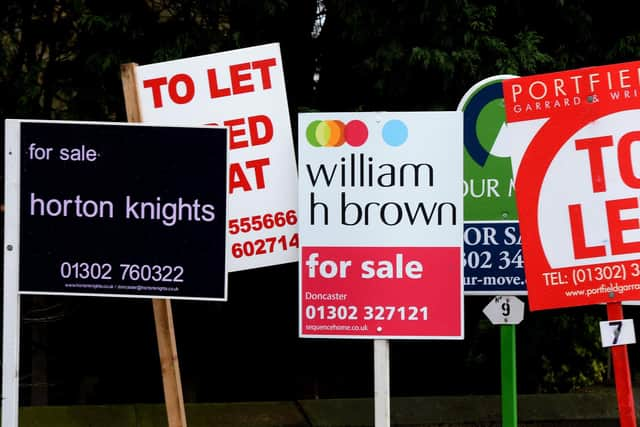Are house prices falling in Derbyshire? Check the local property market with our interactive tool
and live on Freeview channel 276
Official house price data for December has failed to alleviate concerns about the market slowdown, with prices now falling month-on-month across the UK - although they are still rising on an annual basis.
It follows a disastrous mini-budget under the short-lived premiership of Liz Truss who, alongside her chancellor Kwasi Kwarteng, sent mortgage interest rates spiralling after the prospect of massive tax cuts spooked financial markets.
Advertisement
Hide AdAdvertisement
Hide AdAre house prices rising or falling in Derbyshire?


But what do the official figures say about property prices across Derbyshire - are they rising, or is our area one of the dozens across the UK where prices started to tumble last month? We have all the answers for you here, alongside an interactive chart that will let you explore what the statistics are telling us about the local property market.
The Office for National Statistics (ONS) and HM Land Registry published the latest official house price data on Wednesday, known as the UK House Price Index.
In Chesterfield, prices stayed more or less the same last month, increasing by just 0.1%. The average house price stood at £202,603 in December – but contributed to an 11.4% rise compared to December last year, when the average was £181,795.
In the High Peak, house prices increased by 1.2% in December, adding to the 16.1% growth over the last year. The average High Peak house price in December was £267,806.
Advertisement
Hide AdAdvertisement
Hide AdProperties in Erewash increased by 1.1%, adding to the growth of 8.8% over the last year. The average Erewash house price in December was £213,377.
In Bolsover, though, House prices dropped slightly, by 0.4%, in December. Over the last year proces still grwe by 13% though, with the average house price in December at £177,550.
The Derbyshire Dales also saw a drop, of by 0.5% in December. Average prices still grew last year though by 12.9% to reach an average of £346,218.
Amber Valley saw the biggest fall though, with prices down by 2.6%. But the drop does not reverse the longer-term trend, which has seen property prices in the area grow by 12.5% over the last year to £231,025.
Advertisement
Hide AdAdvertisement
Hide AdThe UK House Price Index is based on property sales rather than asking prices or mortgage data, and is therefore considered the most reliable barometer of UK house sale activity.
Across the UK, house prices have risen by 9.8% in the last year, from £268,115 to £294,329. While prices may be much higher than last year, the rate of inflation has slowed – prices were up 10.6% in the year to November, and 12% in the year to October. The ONS said some of the recent annual inflation rates have been volatile due to fluctuations in prices during 2021. For instance, there was a sharp fall in average prices in October 2021 following the end of the Stamp Duty holiday, which made year-on-year growth in October 2022 particularly high.
Alongside an average cost, the House Price Index data also offers a more detailed view of the housing market, with average prices published for detached, semi-detached, and terraced homes, flats, and prices faced by first-time buyers.
Our sister title NationalWorld has created an interactive chart that shows how house prices have fared for different types of property in Derbyshire and other council areas over the last five years.
Advertisement
Hide AdAdvertisement
Hide AdThe biggest year-on-year growth came in West Lancashire where prices were up by 23.8%, followed by Blaenau Gwent in Wales, on 23.3%. Prices were down in just seven councils, all but one of which (Aberdeen, where prices were down 4.9% year-on-year) were in London.
On a monthly basis however, over 170 local authority areas saw house prices fall.
Across the UK as a whole, semi-detached properties saw the strongest growth, with prices up by 11.2% year-on-year. Prices for flats meanwhile were up by only 6.4%.
What will happen to the housing market in 2023?
The Bank of England is warning that the supply of homes for sale is increasing faster than demand, and that higher borrowing costs and concerns about affordability are “weighing significantly” on first-time buyers.
Advertisement
Hide AdAdvertisement
Hide AdAs a result, the majority of offers put in by potential buyers are now below the asking price, and the number of house viewings taking place has fallen sharply, according to insight from the Bank’s contacts in the housing market.
HM Land Registry says the housing market will “remain on a downward trajectory over the coming months”, with monthly data from the Bank of England showing fewer mortgages were approved in December – the fourth consecutive monthly decrease. If the Covid pandemic period is excluded, the number of new mortgages approved are at their lowest level since January 2000, it said.
